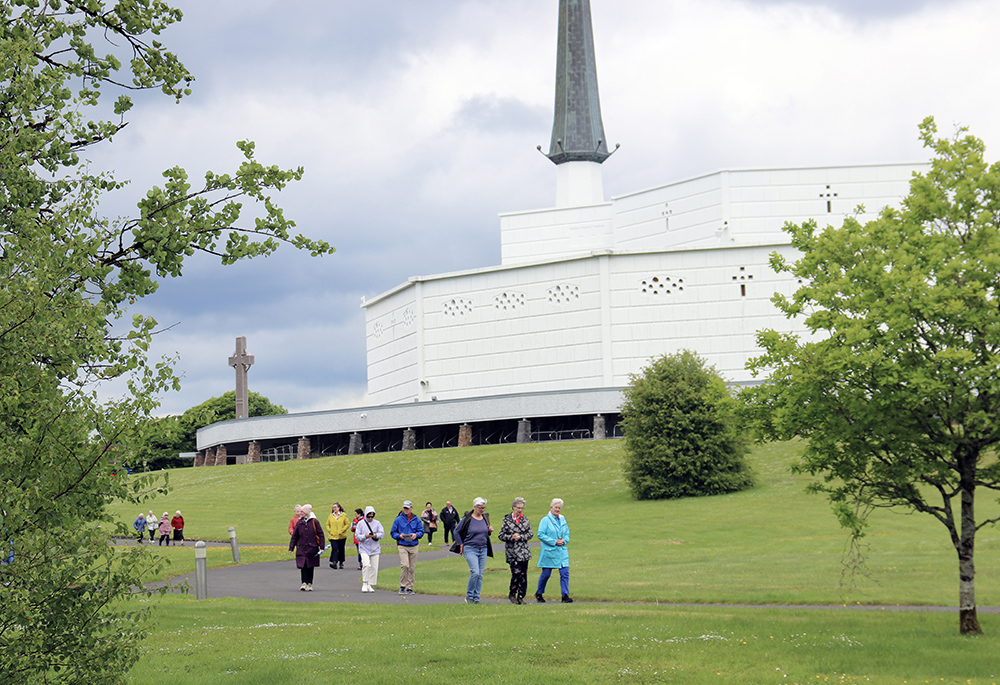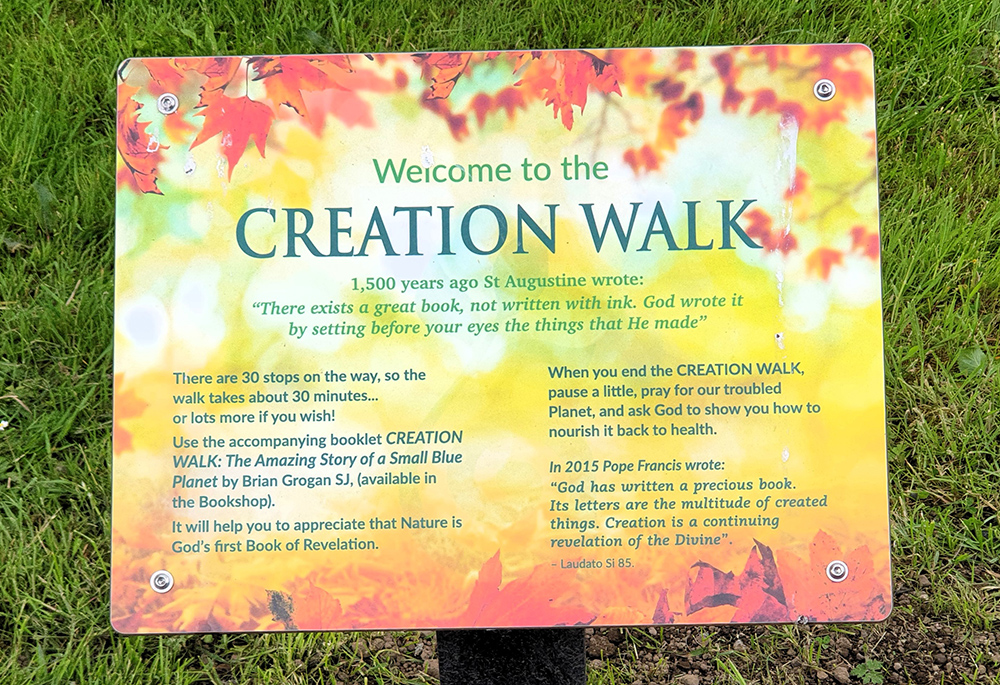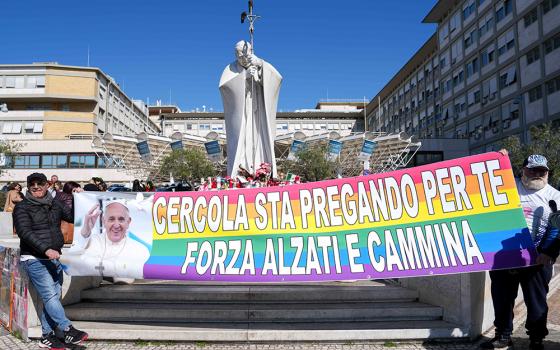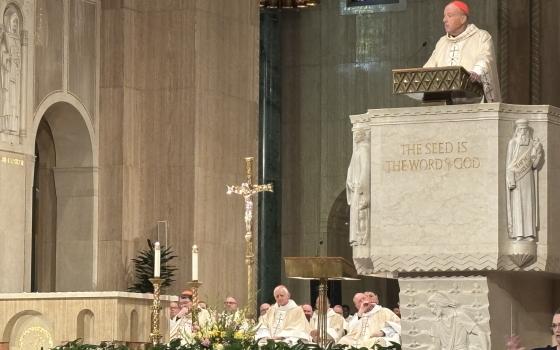
Jesuit Fr. Brian Grogan and Fr. Richard Gibbons, rector of Knock Shrine, are pictured at the launch of the Creation Walk at Knock Shrine, May 25 in Knock, County Mayo, Ireland. (Sinead Mallee)
Creation Walks are being developed across Ireland to convey, in local settings, the long journey of the universe and the importance of caring for the Earth, as Jesuit Fr. Brian Grogan explains. And now he has designed one of his own.
The new Creation Walk on the grounds of Ireland's national and international Marian and Eucharistic Shrine in Knock, County Mayo, offers a quiet space to pilgrims for personal reflection and to appreciate nature and listen to birdsong, according to the Knock Shrine website. Beginning at Knock Museum's car park, this wheelchair-friendly, half-kilometer walk winds its way discreetly around a tree-lined and secluded section of the grounds of the shrine and continues through a small area of woodland.
Knock's Creation Walk was formally launched on May 25 by the rector of Knock Shrine, Fr. Richard Gibbons. In his address, Gibbons said he hoped the Creation Walk would open pilgrims' eyes to their responsibility for "this wonderful planet of ours for future generations."
The walk incorporates 30 stations that tell the story of creation from the beginnings of the universe to humanity walking on the moon, and the conversation in 2017 between Pope Francis and the crew of the International Space Station. Each stop along the walk provides a scriptural quote to encourage participants to pause and prayerfully reflect on God's creation.

Visitors to Ireland's Knock Shrine are pictured on the newly launched Creation Walk, May 25, in Knock, County Mayo, Ireland. (Sinead Mallee)
The stations were designed by Grogan as standalone meditations or to be used with the companion booklet, Creation Walk: The Amazing Story of a Small Blue Planet. Grogan's booklet was written in 2020 and was meant to coincide with the launch of Knock's Creation Walk, but the COVID-19 pandemic scuttled those plans.
Referring to Grogan's ministry as a prayer guide within Knock's faith community, Gibbons said the priest "always brought what industrial gurus call 'blue sky thinking' " to any group that he was part of "and had a capacity to think a little bit differently to others." Knock's Creation Walk is an example of this, he said, and it is now a permanent fixture in the physical and spiritual landscape of the shrine.
Grogan found the launch "very moving" as an octogenarian waiting to see the efforts finally come to fruition. He hopes that readers of the booklet and those who do the Creation Walk will "take a contemplative approach to nature" and look at Celtic Christianity where "everything is mysterious, complex and wonderful." Care for creation, he said, brings both joy and pain due to the beauty and destruction of things.

Jesuit Fr. Brian Grogan speaks to an audience during the launch of Creation Walk May 25 at Knock Shrine. (Sinead Mallee)
Addressing more than 150 people assembled in Knock's Prayer Centre for the launch of the walk, Grogan said, "What we are celebrating today is our common heritage and our intention to do something about this world — our common home." He said he thinks of creation as "a vast banquet" that has been provided by God, and all species are together, sitting equally around the banquet table.
The 86-year-old recalled the first time he experienced the completed walk. At Station Five he saw a little robin standing on the information post stretching out its wings, "as if to say, 'This is mine!' "
"It is not a walk to rush through or 'to do,' but to ponder and contemplate," he said.
Speaking to EarthBeat, Grogan explained that the "emphasis" of the walk in Knock is wedding science and religion. "This is an attempt not to laud one and squash the other, but to create an environment in which religion and science illuminate each other," he said. "What is given in Genesis has its own correctness and its own wonder. It is not trying to be scientific. While theology can tell us that God made the world, science tells us how God went about it and how God is going about it. Science tells us what the story is."

Visitors to Knock Shrine walk through the grounds. (Sinead Mallee)
In his address, Gibbons paid tribute to the ease with which science sits "comfortably" with faith and Scripture in Knock's Creation Walk. His urged those trapped in the "old ridiculous trope that science and faith will never agree" to read the encyclical "Laudato Si', on Care for Our Common Home," in which Pope Francis "calls us to eco-conversion and to transform our understanding and relationship with nature, in whatever small steps we can make for the common good, and for the good of God's own creation."
In the face of the climate crisis and environmental challenges, Gibbons said people might be tempted to despair and conclude, "My little effort isn't worth anything." They might think it is up to those in positions of power and big corporations to address the challenges. "Absolutely, they should be involved because it won't work without them. But we can diminish what we ourselves can do to the point that we don't do anything," he cautioned, adding, "We are not silent observers."
Grogan explained, "Each pause on the walk gives us a chance to realize that the natural world is silently pleading with the 1 million pilgrims who annually come to Knock Shrine to play their part in protecting, conserving and beautifying our common home. Nature is entrusting itself to our sensitive care. It is a place to fall more deeply in love with our God who caresses us with a leaf, a tree, a bird and a cloud, with a stone and a sunbeam."

A sign is pictured from the Creation Walk at Ireland's national and international Marian and Eucharistic Shrine in Knock, County Mayo. (Sarah Mac Donald)
Grogan lamented the fact that Christian history is not renowned for its care of the Earth, saying, "This is due to a distorted spirituality which saw matter as corrupting and taught that the things of this world were to be despised and looked down on." Laudato Si' signaled an "extraordinary conversion," he said, "All of that is reversed. I can love nature; it is given to me to love."
"Eco-conversion is our path. We need to be converted and conversion means something like falling in love. We protect what we fall in love with!" said Grogan.
He thinks people like British broadcaster and naturalist, David Attenborough, "are turning the pages of creation," and through them, "we are coming to know pages that we never knew before" and to develop a "sense of wonder in these things."
Advertisement
"Jesus, when he was in the world, looked lovingly on all these things, and his loving was a kind of gathering of all things to himself. So they are present to him now. They are not over and done with. They are alive. Everything that passes in our world is alive from God's point of view. Theologically, we would be saying that all things are present to God, always were, and always will be. That is the new creation that is developing in the mystery of things. The new heavens and the new earth that Scripture hints at are actually underway at the moment. In Laudato Si', Pope Francis instances the Eucharist where you are taking ordinary bread and ordinary wine, and they are transformed into what is divine. That is a hint to us day by day that the divinizing of creation is well underway. We play our part in that," said Grogan.

Jesuit Fr. Brian Grogan, wearing a blue coat, participates in a tree planting at the Creation Walk at Knock Shrine. Also pictured is Fr. Richard Gibbons, left, rector of Knock Shrine, and horticulturalist Dylan Prendergast. (Sinead Mallee)
At the launch of the Creation Walk in Knock, Grogan cited American marine biologist and nature writer Rachel Carson's 1962 book, Silent Spring, for its prescient warning over the misuse of pesticides. Sadly, he remarked, "very little was done" in response to Carson's appeal. Earlier this year, RTE — the Irish state broadcaster — reported that the dawn chorus was quieter than before.
"The sixth mass extinction is well and truly underway," said Grogan. "Our task, as the poet says, is beauty. Our task is to love all of our fellow creatures, to put success to one side and just act out of love. Love does not come to an end."
He hopes that Knock can be developed as "a center of excellence for care of the environment in education, dialogue, decisions and simply as a presence of beauty."








